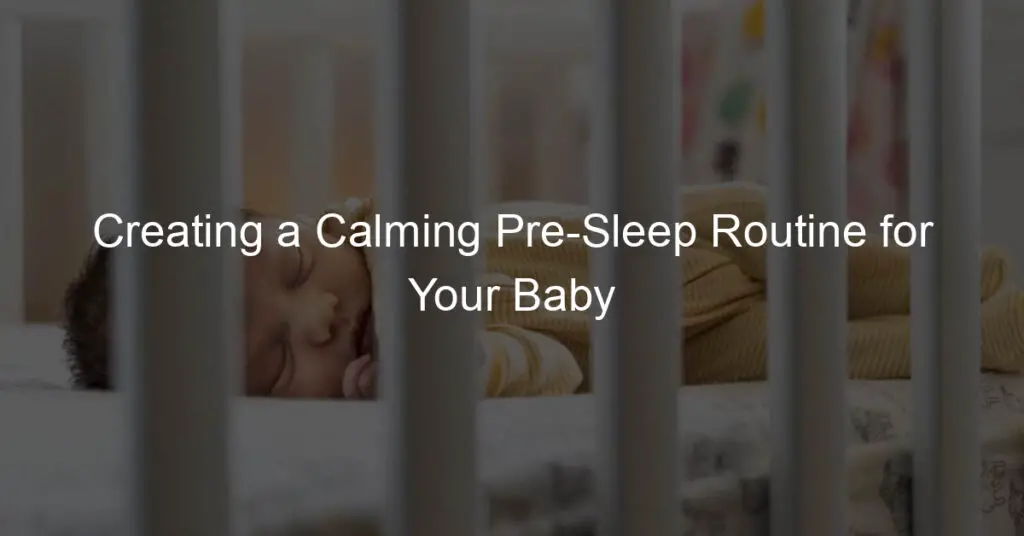The blog post discusses the importance of a pre-sleep routine for babies. It provides a comprehensive guide to help parents understand how to create a calming pre-sleep routine to ensure that their child gets a good night’s sleep. It also explains the potential benefits of a steady sleep schedule and shares some effective strategies that can be implemented.
The Importance of a Pre-Sleep Routine: Why Bother?
Establishing a pre-sleep routine for your baby is essential for several reasons. Firstly, it helps signal to your little one that it is time to wind down and prepare for sleep. This routine acts as a cue for their body and mind, helping them transition from wakefulness to a relaxed state conducive to sleep. Secondly, a consistent pre-sleep routine can help regulate your baby’s internal body clock, promoting a more regular sleep schedule. This is particularly important as it helps establish healthy sleep patterns and ensures that your baby is getting the recommended amount of sleep for their age. Finally, a pre-sleep routine can be a special bonding time between you and your baby, providing an opportunity for quiet, calming activities that promote relaxation and a sense of security.
Creating a Calming Environment:
One of the key elements of a pre-sleep routine is creating a calming environment for your baby. This includes ensuring the sleep environment is quiet, dark, and at a comfortable temperature. Dimming the lights and using blackout curtains can help signal to your baby that it is time to sleep. Additionally, using a white noise machine or a fan can help drown out any external noises that may disrupt your baby’s sleep. Creating a cozy and soothing space will help your baby feel safe and secure, making it easier for them to relax and fall asleep.
Understanding Your Baby’s Sleep Cycle
Understanding your baby’s sleep cycle is crucial in developing an effective pre-sleep routine. Babies have shorter sleep cycles compared to adults, typically lasting around 45 minutes to an hour. During these cycles, they alternate between light and deep sleep. In the initial stages of sleep, known as non-rapid eye movement (NREM) sleep, your baby will be in a light sleep state. Their eyes may flutter, and they can easily be awakened during this phase. As the sleep cycle progresses, your baby will enter deep sleep, also known as rapid eye movement (REM) sleep. This is when dreams occur, and the brain is most active. It is during this phase that your baby is least likely to be easily awakened.
It is important to note that babies spend a significant portion of their sleep time in REM sleep. This is because their brains are rapidly developing, and REM sleep is essential for their cognitive and emotional development. Understanding your baby’s sleep cycle can help you time the pre-sleep routine to coincide with their transition from light sleep to deep sleep. By initiating the routine during the light sleep phase, you can help your baby relax and enter a deeper, more restorative sleep.
Creating a Calming Environment: What Works?
When it comes to creating a calming environment for your baby, there are several factors to consider. First and foremost, keeping the room at a comfortable temperature is essential. Babies sleep best in a slightly cooler room, around 68 to 72 degrees Fahrenheit. Ensuring good ventilation and airflow can also contribute to a peaceful sleep environment.
Another important aspect is the use of soft lighting. Harsh, bright lights can be stimulating and disrupt your baby’s ability to fall asleep. Instead, opt for dimmer lights or use a night light with a warm, gentle glow. This can help create a soothing atmosphere and signal to your baby that it’s time to wind down.
Noise levels also play a significant role in creating a calming environment. While complete silence may not be realistic, minimizing loud or sudden noises can help your baby relax. Consider using white noise machines or apps that produce gentle sounds like rainfall or ocean waves. These consistent, soothing sounds can help drown out any disruptive noises and create a more peaceful sleep environment for your baby.
In addition to temperature, lighting, and noise, consider the overall aesthetics of the room. Choose soft, calming colors for the walls and bedding. Avoid overly stimulating patterns or bright colors that may be distracting. Keep the room clutter-free and organized, as a tidy space can promote a sense of calm.
Finally, consider the use of comforting scents. Lavender, chamomile, and vanilla are known for their relaxing properties. You can use essential oils or scented candles (placed out of reach) to gently infuse the room with these soothing scents. However, it’s important to ensure that the scents are not overpowering or irritating to your baby’s sensitive nose.
“Sleep is not the enemy.” – Creating a Positive Sleep Association
When it comes to establishing healthy sleep habits for your baby, it is important to create a positive association with sleep. This means that sleep should not be seen as something negative or a battle to be fought. Instead, it should be viewed as a necessary and enjoyable part of their routine. By creating a positive sleep association, you can help your baby develop a healthy attitude towards sleep that will benefit them in the long run.
- 1. Consistency is Key:
One of the most important aspects of creating a positive sleep association is consistency. Establishing a consistent sleep routine helps signal to your baby that it’s time to wind down and prepare for sleep. This can include activities such as a warm bath, gentle massage, or reading a bedtime story. By consistently following the same routine, your baby will start to associate these activities with sleep and begin to feel calm and relaxed. - 2. Comfort and Security:
Another crucial element in creating a positive sleep association is providing your baby with a sense of comfort and security. This can be achieved through the use of a lovey or a special blanket that they associate with sleep. These comfort objects can provide a sense of familiarity and help your baby feel safe and secure when it’s time to sleep. Just make sure to choose objects that are safe and age-appropriate. - 3. Responding to Your Baby’s Needs:
It’s important to respond to your baby’s needs during the sleep routine. This means being attentive to their cues and providing comfort when necessary. Whether it’s a quick cuddle, a gentle word of reassurance, or a feeding, responding to your baby’s needs helps create a positive association with sleep. It reassures them that you are there for them and that sleep is a time of comfort and care.
The Magic of a Bedtime Story: Old Tale or New Trend?
Bedtime stories have been a cherished tradition for generations, but in recent years, they have gained even more popularity as a key component of a calming pre-sleep routine for babies. It’s not just an old tale; it’s a powerful tool for promoting relaxation and fostering a love for reading in young children. Reading to your baby before bed not only helps them wind down, but it also provides a multitude of cognitive and emotional benefits.
- 1. Language Development:
Bedtime stories expose babies to a wide range of vocabulary and sentence structures, helping to expand their language skills. As you read aloud, your baby is absorbing the sounds and rhythms of language, which aids in their own language development. - 2. Bonding Time:
Sharing a bedtime story with your baby creates a special bonding experience. It’s a time for closeness, eye contact, and soothing tones of your voice. This shared experience helps strengthen the parent-child bond and creates a sense of security and comfort for your little one. - 3. Imagination and Creativity:
Bedtime stories ignite the imagination and spark creativity in young minds. Through colorful illustrations and captivating narratives, children are transported to different worlds, allowing them to explore their own creativity and imagination. - 4. Emotional Development:
Stories often contain characters and situations that reflect real-life emotions and experiences. By engaging with these stories, babies can learn about empathy, emotions, and problem-solving. They begin to understand different feelings and develop emotional intelligence. - 5. Relaxation and Sleep Induction:
The rhythmic and soothing nature of storytelling has a calming effect on babies. As you read to them, their bodies naturally begin to relax, and their minds become focused on the story. This helps create a peaceful transition from wakefulness to sleep, making bedtime less stressful for both baby and parent.
Can White Noise be the Solution?
White noise has gained popularity as a potential solution for promoting better sleep in babies. This consistent, soothing sound can create a calming environment that mimics the sounds of the womb, making it easier for babies to fall asleep and stay asleep. The gentle hum of white noise can help drown out other noises that may disrupt your baby’s sleep, such as household sounds or outside traffic. It creates a consistent background noise that can be comforting and familiar to your little one.
However, it’s important to note that white noise should be used in moderation and at a safe volume. Excessive or loud white noise can potentially damage your baby’s hearing, so it’s crucial to use a white noise machine or app that allows you to control the volume. Additionally, it is recommended to place the white noise machine at a safe distance from your baby’s ears and not directly in their crib.
White noise can be particularly helpful for babies who have difficulty settling down or those who are easily disturbed by environmental noises. It can provide a sense of comfort and security, creating a consistent sleep environment that helps establish a healthy sleep routine. When used appropriately, white noise can be a valuable tool in promoting better sleep for your baby.
However, it’s important to remember that every baby is different, and what works for one may not work for another. Some babies may find white noise soothing, while others may not respond to it at all. It’s always best to observe your baby’s reaction to white noise and make adjustments accordingly.
The Role of Comfort Objects in Sleep Time
Comfort objects, such as a favorite blanket, stuffed animal, or pacifier, can play a significant role in helping your baby feel secure and calm during sleep time. These objects provide a sense of familiarity and comfort, acting as a source of reassurance when your baby is transitioning into sleep. Here are three subheadings that further explore the role of comfort objects in sleep time:
- 1. Transitioning from Parental Presence:
Many babies rely on their parents’ presence to fall asleep initially. However, introducing a comfort object can help bridge the gap between the baby’s need for parental comfort and their ability to self-soothe. The soft texture or familiar scent of the object can provide a sense of security, making it easier for your baby to settle down and fall asleep. Gradually, the comfort object can become a replacement for the parent’s physical presence, helping your baby learn to self-soothe and sleep more independently. - 2. Consistency and Sleep Associations:
Comfort objects can also act as sleep associations, signaling to your baby that it’s time to sleep. When used consistently as part of a pre-sleep routine, the presence of the comfort object can cue your baby’s brain that it’s time for rest. This association can be particularly helpful during night wakings, as the presence of the comfort object can help your baby feel secure and ease them back to sleep. - 3. Transitioning Environments:
Comfort objects can be especially valuable during times of transition, such as traveling or moving to a new environment. These objects provide a sense of familiarity and continuity in an unfamiliar setting, helping your baby feel more at ease and facilitating better sleep. Whether it’s a familiar stuffed animal or a cozy blanket, having their comfort object with them can provide a sense of security and help your baby adjust to the new surroundings more smoothly.
Are You Overlooking the Importance of a Good Night Light?
When it comes to creating a calming pre-sleep routine for your baby, one element that is often overlooked is the importance of a good night light. A night light can serve as a gentle source of illumination in your baby’s sleep environment, providing a sense of security and comfort during the night.
A night light can help alleviate your baby’s fear of the dark, which is a common fear that many children experience. The soft glow of a night light can create a soothing atmosphere, making your baby feel safe and less anxious. It can also make it easier for you to check on your baby without disturbing their sleep by turning on a bright overhead light.
Moreover, a good night light can help in nighttime feedings or diaper changes. By providing a dim, ambient light, it allows you to navigate the room and attend to your baby’s needs without fully waking them up. This can help maintain a calm and peaceful sleep environment, ensuring that both you and your baby can quickly return to sleep after nighttime awakenings.
When choosing a night light, opt for one with adjustable brightness levels or a dimmer switch. This allows you to customize the level of light based on your baby’s preference and sleep environment. Additionally, consider using a warm-colored light rather than a bright, blue light, as blue light can interfere with your baby’s natural sleep-wake cycle.
Remember to place the night light at a safe distance from your baby’s sleeping area to avoid direct exposure to their eyes. Ideally, position it in a spot where it provides a soft, diffused glow throughout the room without being too bright or too close to your baby’s crib or bed.
The Impact of Food and Drink Before Bed: Are You Helping or Hindering?
The food and drink your baby consumes before bed can have a significant impact on their sleep quality and overall bedtime routine. While it’s important to ensure that your baby is well-nourished, certain types of foods and drinks can either help or hinder their ability to fall asleep and stay asleep throughout the night.
First, it’s essential to consider the timing of meals and snacks before bed. Offering a heavy or large meal too close to bedtime can make digestion more difficult for your baby, leading to discomfort and potential sleep disturbances. On the other hand, providing a light and balanced meal or snack a couple of hours before bed can help promote a more restful sleep.
Secondly, pay attention to the types of foods and drinks you offer before bed. Some foods and beverages, such as those high in sugar or caffeine, can stimulate your baby’s energy levels and make it harder for them to wind down and relax. Opt for healthier options like fruits, vegetables, and whole grains, and limit or avoid sugary treats and caffeinated beverages altogether.
Finally, consider the impact of hydration before bed. While it’s important to keep your baby adequately hydrated throughout the day, offering too much liquid close to bedtime may result in more frequent nighttime awakenings for bathroom trips. It’s a good idea to offer fluids earlier in the evening and limit the amount closer to bedtime to avoid disruptions.
How Much Sleep Does Your Baby Actually Need?
It’s essential to understand the amount of sleep your baby needs at different stages of their development. Adequate sleep is crucial for their growth, development, and overall well-being. Here are three key subheadings to consider when determining how much sleep your baby actually needs:
- 1. Newborns (0-3 months):
During the first few months of life, newborns require a significant amount of sleep. On average, they need around 14-17 hours of sleep per day, which is typically spread out in short periods of sleep throughout the day and night. Newborns have irregular sleep patterns and tend to wake up frequently for feeding, diaper changes, and comfort. - 2. Infants (4-11 months):
As your baby grows, their sleep patterns begin to change. By four months, many babies begin to establish more regular sleep-wake cycles and longer stretches of sleep at night. Infants in this age range require about 12-15 hours of sleep per day, including nighttime sleep and naps. Most infants will have three naps during the day, gradually transitioning to two naps as they approach their first birthday. - 3. Toddlers (1-3 years):
Once your baby becomes a toddler, their sleep needs continue to evolve. Toddlers typically require about 11-14 hours of sleep per day, which includes nighttime sleep and a daytime nap. By the age of two, most toddlers will transition to a single afternoon nap that lasts for a few hours. Establishing a consistent sleep schedule and bedtime routine becomes even more important during this stage to promote healthy sleep habits.
“Is a bedtime routine necessary?” – The Power of Consistency
Establishing a regular bedtime routine for your baby is not just a luxury but a necessity. Consistency in your baby’s sleep routine can have a significant impact on their sleep quality and overall well-being. Here are three reasons why a bedtime routine is essential:
- 1. Promotes Relaxation and Calmness:
A consistent bedtime routine signals to your baby that it’s time to wind down and prepare for sleep. By following the same sequence of activities each night, such as a warm bath, gentle massage, and quiet time, you create a predictable and soothing environment that helps your baby relax. This routine triggers the release of sleep-inducing hormones, preparing your baby for a restful night’s sleep. - 2. Sets Sleep Associations:
Babies are creatures of habit, and they thrive on predictability. By establishing a consistent bedtime routine, you create positive sleep associations. When your baby consistently associates certain activities or cues with sleep, such as reading a bedtime story or playing soft music, it becomes easier for them to transition from awake to asleep. These associations provide comfort and security, making it easier for your baby to settle down and fall asleep. - 3. Regulates Sleep-Wake Cycles:
A bedtime routine helps regulate your baby’s internal clock, also known as the circadian rhythm. By consistently following a specific routine, you reinforce the body’s natural sleep-wake cycles. This consistency helps synchronize your baby’s internal clock with the external day-night cycle, promoting better sleep patterns. Over time, your baby’s body will naturally start to recognize the routine as a signal for sleep, making it easier for them to fall asleep and stay asleep throughout the night.
Adapting to Changes: What Happens When the Routine is Disrupted?
Life is full of unexpected events and disruptions, and as parents, it’s inevitable that your baby’s bedtime routine will occasionally be disrupted. Whether it’s due to travel, illness, or other unforeseen circumstances, it’s important to understand how these disruptions can affect your baby’s sleep and how to adapt accordingly.
When a routine is disrupted, your baby may become disoriented and find it difficult to settle down for sleep. They may resist bedtime, become fussy, or experience shorter and more disrupted sleep periods. This is because routines provide a sense of security and familiarity, and any deviation from that can unsettle your baby’s sleep patterns.
To help your baby adjust to changes in routine, try to maintain as much consistency as possible. Stick to familiar rituals or activities that are part of your routine, even if the timing or order is slightly different. For example, if you’re traveling and unable to follow your usual bedtime routine, try to incorporate elements such as reading a story or using a comfort object to provide a sense of familiarity.
It’s also important to be patient and understanding during these disruptions. Your baby may need extra reassurance and comfort during this time. Offer soothing words, gentle touch, or additional cuddles to help them feel secure. Be prepared for the possibility of more night wakings or shorter sleep periods, as your baby adjusts to the changes.
Once the disruption has passed, gradually reintroduce your regular routine. It may take a few days for your baby to readjust, but with consistency and patience, they will regain their sense of stability and return to their normal sleep patterns.
Tips and Tricks for Making the Routine Stick
Establishing a pre-sleep routine for your baby is one thing, but making it stick can be another challenge altogether. However, with some helpful tips and tricks, you can ensure that your baby’s bedtime routine becomes a consistent and effective part of their sleep schedule.
- 1. Start early:
It’s never too early to establish a routine. Begin incorporating calming activities and rituals into your baby’s bedtime routine from a young age, so it becomes a familiar and expected part of their bedtime routine. - 2. Be consistent:
Consistency is key when it comes to making the routine stick. Try to follow the same sequence of activities and establish a regular bedtime each night. This helps signal to your baby’s body that it’s time to wind down and prepare for sleep. - 3. Keep it simple:
A pre-sleep routine doesn’t need to be complicated. Stick to a few soothing activities that work for your baby, such as a warm bath, gentle massage, or quiet playtime. Keeping it simple helps your baby associate these activities with sleep. - 4. Allow for flexibility:
While consistency is important, it’s also essential to allow for some flexibility. There may be times when your schedule or circumstances require slight adjustments to the routine. Be adaptable, but try to maintain the overall structure and purpose of the routine. - 5. Involve your baby:
As your baby grows older, involve them in the routine. Allow them to choose a book for bedtime reading or give them a sense of control by letting them pick out their pajamas. This involvement can help them feel more engaged and cooperative during the routine. - 6. Be patient:
Rome wasn’t built in a day, and neither will your baby’s routine. It takes time for habits to form, so be patient and consistent. Stick with the routine even if there are occasional setbacks or resistance from your baby.
Creating a Calming Pre-Sleep Routine for Your Baby:
| Step | Description | Time Needed | Benefits |
|---|---|---|---|
| Set a consistent bedtime | Set a consistent bedtime and stick to it. This will help your baby develop a regular sleep schedule. | 10 minutes | Helps your baby develop a regular sleep routine |
| Create a calming atmosphere | Dim the lights, play calming music, and create a comfortable sleep environment. | 15 minutes | Helps your baby relax and feel at ease |
| Provide a bath or massage | Give your baby a warm bath or massage before bed. This will help them relax and feel comfortable. | 20 minutes | Helps your baby relax and promote better sleep |
| Read a book | Read a calming story to your baby before bed. This will help them wind down and prepare for sleep. | 10 minutes | Helps your baby relax and encourages learning |
Establishing a pre-sleep routine for your baby is not just about getting them to sleep through the night. It’s about creating a secure environment that promotes healthy sleep habits. Remember, consistency is key, and while it may take some time, the benefits for both you and your baby are worth it. With patience, understanding, and adaptation to what works best for your child, you can create a calming pre-sleep routine that works.














